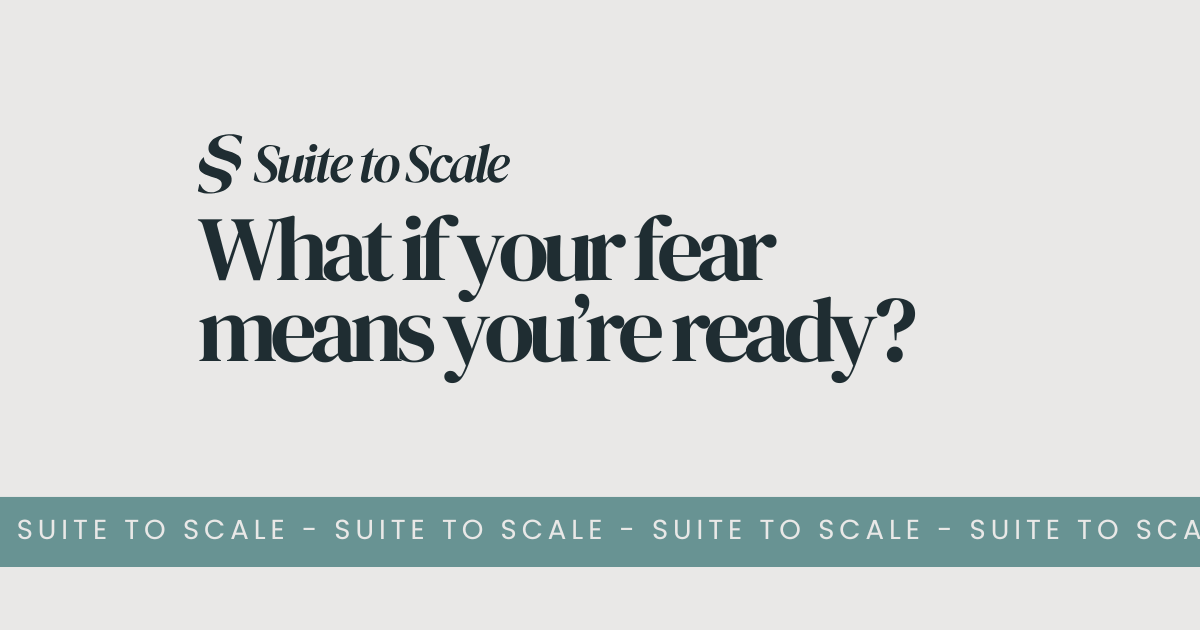- Suite to Scale
- Posts
- 🍭What if your fear means you’re ready?
🍭What if your fear means you’re ready?
Doubt doesn’t disappear, but you can move anyway.

Hey, it’s Kat here 👋
This past week I’ve chatted to a few business owners that are stepping into the world of digital products and courses and there was one thing almost everyone had in common.
⟫ Self doubt.
I’ve been working on developing new offers myself and let me tell you the self doubt, fear, and imposter syndrome showed up in full force (even after 9 years of developing courses).
Here are some common thoughts that popped up for the people I chatted with:
⟫ What if I put all this work in and no one buys it?
⟫ Who am I to teach this? Someone else in my space probably does it better.
⟫ What if people hate it and leave bad reviews?
If you’ve ever had one (or all) of these thoughts, I want you to know… it doesn’t mean you’re not ready, capable, or that you should stop.
It means you’re growing, and stretching.
It means you care deeply about what you put out into the world.
Self-doubt doesn’t show up when you’re playing it safe and staying exactly where you are. It shows up when you’re moving beyond your current comfort zone, and stepping into something bigger.
🍭 What if self-doubt is actually proof you’re expanding?
Our brains are wired to keep us safe.
They love the familiar.
New ideas, new offers, or new target audiences? Those usually feel risky.
And when your brain senses risk, it sends up self-doubt as a protective mechanism. At least, that has been my experience in life and business 🫠
But too much safety in business can mean staying small and not using your full potential.
Staying exactly where you are, even when you know there’s something more for you, can hold you back from feeling fulfilled.
Instead of seeing self-doubt as a red stop light, try seeing it as a sign you’re stepping into the next stage of growth and discovery.
That discomfort you’re feeling? It’s part of the process.
❔How can you turn self-doubt into momentum?
When those heavy thoughts pop up, try this:
⟫ Write it down exactly as it is.
Get it out of your head and onto paper so it stops swirling around and growing bigger and bigger.
⟫ Ask: What is this thought protecting me from?
Usually it’s fear of failure, judgment, or disappointment. Naming it takes away its mystery.
⟫ Ask: What would future-you do anyway?
What action would the version of you who already has the business you want take next? Then… do that. Even if it’s small.
⟫ Ask: What happens if my worst fear comes true? What would I actually do?
This helps you see what you would do in reality if the doubt became reality. Take a moment to think about what actions you would take (in real life) if this thing came true.
💭 The truth behind common doubts
DOUBT: What if I put all my time and energy into this and it doesn’t sell?
It will sting.
But it also gives you data.
You’ll learn, adjust, and come back stronger.
Most people stop too soon to ever find out what’s possible.
My best tip here? Pre-sell your offer first.
This allows you to put effort into the transformation, the outline, and the sales page before you ever build a single module.
You get paid validation before investing months creating something no one buys.
How did I do this?
When I launched The Pinterest Gameplan, I pre-sold it. After 10 students signed up, I built it and delivered it live. It helped me learn what my students needed most.
Years later, when I decided to completely overhaul the course, I did it again. I pre-sold the new version, then built and delivered it live over 12 weeks.
Pre-selling is the best way to make sure what you create is what your audience actually wants.DOUBT: Someone else has created something similar and it's probably way better than mine.
There is always someone ahead of you in business. But no one has your exact voice, your exact stories, or your exact way of teaching.
That’s your edge.
There are countless shoe brands selling running shoes. Imagine if one of them said, "We can’t create shoes because Nike already does." Each brand found its niche, its unique focus, its community.
Competition isn’t a stop sign, it’s proof there’s a market. And remember, your audience connects to your way of teaching. That’s irreplaceable.DOUBT: What if they leave me a bad review?
They might and you’ll survive.
One negative voice doesn’t erase the lives you’ll impact.I always ask, "What would I actually do if someone left a bad review?"
This exercise usually highlights where you think your program might need tightening. It gives you a chance to improve and clarify.Your program isn’t for everyone.
Your sales page should filter out those who aren’t the right fit but you’ll still occasionally get people who aren’t.
Most people who feel misaligned won’t leave a public review, they’ll reach out to you. This is your opportunity to clarify and respond gracefully.Just like a restaurant handles feedback, you can respond with facts, highlight who your program is for, and clarify expectations.
Ask yourself, "How would I handle it?". Usually, you’ll find it’s much more manageable than your mind makes it out to be.
🎯 This week’s action:
Next time self-doubt pops up, don’t push it away.
→ Write it down and follow the questions I shared above.
Get curious about what it’s trying to protect you from.
Then choose one small action that future-you would take anyway.
Your momentum won’t come from eliminating doubt, it’ll come from moving forward alongside it.
One of the best ways to do that is with accountability, which is what I’ve included in my 1:1 mentoring programs.
Finding someone who can help you when that self doubt pops up, is so helpful. If you have someone in your business life that can help you with that, reach out to them!
🫡 KM Tip of the Week:
The quiet power of a simple nurture email.
Your audience doesn’t always need another “launch” email. So if you are feeling like you need a quiet email or a breather within your launch consider this…
Sometimes they need a story, a moment of connection, or a tiny behind-the-scenes glimpse.
A quiet nurture email can build trust and deepen the relationship during a launch.
I do like to have an option to purchase for those that are ready in all emails but that can mean simply adding a p.s. at the end of a connection email with a link to purchase.
Some emails just remind your reader, “I’m here. I see you. I’m with you. And I understand”.
🦄 I’m In Your Corner:
You’re not behind or too late.
You’re exactly where you need to be.
The fact that you’re even questioning your next move? That’s proof you care deeply about what you’re building.
Trust that.
Trust yourself.
Take the next small step.
I’m cheering you on.
🫠 Meme of the week
When someone asks how many offers I have in my business: proceeds to open a 47-tab spreadsheet.

You’ve already got the ingredients. I’m just here to help you mix them into something that lights you up (and sells out).
Here’s to scaling with clarity, joy, and a little bit of sparkle.
— Kat 🍭
P.S. If you’re second guessing everything and it’s stopping you from taking action on your ideas, my 1:1 strategy and mentoring can help you break through that.
Whether it’s the Your Next 90 session or engaging in ongoing 1:1 mentoring through The Aligned Suite, we can take those ideas and turn them into reality.
I tailor all of my strategy work and mentoring to your unique needs. No cookie cutter approaches (although I do love a good choc chip🍪).
How did you like this week's email?Click your choice to vote in the private poll. |